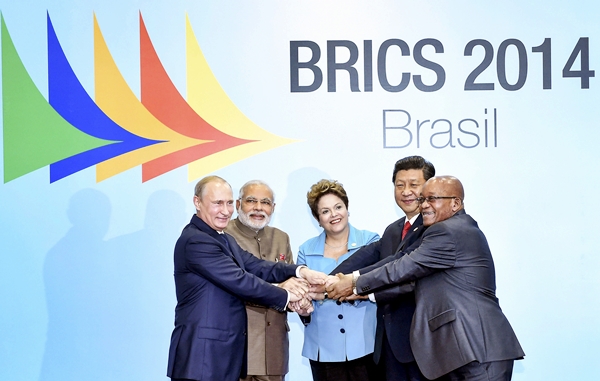India isn’t ‘open for business’ yet

Indian Prime Minister Narendra Modi, second from left, posed for a group photo with Russian President Vladimir Putin, Brazilian President Dilma Rousseff, Chinese President Xi Jinping and South African President Jacob Zuma during the sixth BRICS summit in Fortaleza, Brazil, July 15, 2014. [XINHUA/NEWSIS]

William Pesek
In retrospect, expectations that India’s prime minister would revolutionize a troubled economy overnight were wildly overblown. But three months on, even some Modi skeptics may be wondering if they have been too easy on the great modernizer from Gujarat. Since taking office, Modi has scuttled a global trade deal, sidestepped much-needed subsidy cuts and refrained from letting foreigners hold majority stakes in key domestic sectors. He remains vague about the broader structural reforms partisans hoped he would inaugurate.
Last week, Modi was outmaneuvered by opposition lawmakers on opening India’s insurance industry a bit wider to global investors. On Friday, he announced a bold scheme to turn India into a manufacturing superpower without providing any details - better infrastructure, less red tape, increased training - of how he might pull off such a feat.
Modi’s all-rhetoric-no-reform shtick is becoming all too familiar in Asia. The region’s three biggest economies are being run by self-described reformers - Modi, Japan’s Shinzo Abe and China’s Xi Jinping. All three wooed their populations - and global investors - with talk of epochal change, pledges to shake up fossilized political systems and proposals to replace stagnant industries with new. Buyer’s remorse shows signs of setting in.
In a June 10 column, headlined “Move Over BRICs, Here’s Asia’s Axis of Reform,” I explored the bullish case. The basic idea: A serendipitous coincidence had put the region’s main economic powers in the hands of three leaders who not only appreciated the need for change, but enjoyed uniquely strong mandates. So far, time hasn’t been kind to this thesis.
Start with Japan, where Prime Minster Abe’s stimulus-heavy policies have created more inflation than economic growth. Twenty months ago, Abe promised to lower trade barriers, modernize the tax system, loosen labor markets, encourage entrepreneurship and prod companies to fatten wages. So far, none of the above has happened. The 6.8 percent annualized plunge in second-quarter gross domestic product is but the latest reminder that “Abenomics” is in trouble as the world economy grows more uncertain around Japan. While optimists claim the plunge reflected a one-time growth-hit related to a 3 percentage point sales-tax hike, more recent data hasn’t been much sunnier.
The same goes for China’s Xi. For all the chatter about a “new normal” and “tolerating” slower growth, Beijing’s full attention seems to be on meeting its 7.5 percent growth target. That means more borrowing by local governments, increased credit creation by the shadow-banking industry, less political will to stomach debt defaults - and an even bigger crash down the road. While Xi has cracked down on public graft, Beijing watchers fear his anti-corruption campaign is designed to punish rivals rather than clean up a Communist Party that continues to mint millionaires.
And then there’s Modi. In his fiery Independence Day speech last Friday, as in almost all his public addresses, he signaled that India was open for business again. The message is welcome, with the economy growing more slowly than it has in a decade, and government paralysis blocking investments India desperately needs.
Modi’s Bharatiya Janata Party won a landslide victory in May because voters were convinced he would change this trajectory. He built his reputation as a tough modernizer during his tenure as chief minister of the booming western state of Gujarat. There, limited government, pro-business pragmatism, anti-graft initiatives and a welcoming environment for foreign investment produced 10 percent-plus growth rates. But Modi is stumbling in his efforts to translate that success into national prosperity.
Granted, it’s early days. Modi deserves more time to devise and implement his vision for Asia’s third-biggest economy. But if the prime minister expects patience from a global community that’s watched India squander its potential during the past decade, he’s mistaken. Really, if a supposed maverick with the fattest parliamentary mandate in three decades can’t deliver on easy reforms like opening the insurance industry, what else can the world expect?
Talking about a manufacturing revolution that involves “zero imports” and “zero defects” is catchy stuff, but gimmicky. Like China and Japan, India can’t afford to keep putting off more serious, big-bang reforms. The 2.7 billion people in those countries need less talk from Modi and the rest of Asia’s axis of reform, and more action.
* The author is a Bloomberg View columnist based in Tokyo.
BY William Pesek










with the Korea JoongAng Daily
To write comments, please log in to one of the accounts.
Standards Board Policy (0/250자)